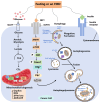Fasting as an Adjuvant Therapy for Cancer: Mechanism of Action and Clinical Practice
- PMID: 39595613
- PMCID: PMC11591922
- DOI: 10.3390/biom14111437
Fasting as an Adjuvant Therapy for Cancer: Mechanism of Action and Clinical Practice
Abstract
The fundamental biological characteristics of tumor cells are characterized by irregularities in signaling and metabolic pathways, which are evident through increased glucose uptake, altered mitochondrial function, and the ability to evade growth signals. Interventions such as fasting or fasting-mimicking diets represent a promising strategy that can elicit distinct responses in normal cells compared to tumor cells. These dietary strategies can alter the circulating levels of various hormones and metabolites, including blood glucose, insulin, glucagon, growth hormone, insulin-like growth factor, glucocorticoids, and epinephrine, thereby potentially exerting an anticancer effect. Additionally, elevated levels of insulin-like growth factor-binding proteins and ketone bodies may increase tumor cells' dependence on their own metabolites, ultimately leading to their apoptosis. The combination of fasting or fasting-mimicking diets with radiotherapy or chemotherapeutic agents has demonstrated enhanced anticancer efficacy. This paper aims to classify fasting, elucidate the mechanisms that underlie its effects, assess its impact on various cancer types, and discuss its clinical applications. We will underscore the differential effects of fasting on normal and cancer cells, the mechanisms responsible for these effects, and the imperative for clinical implementation.
Keywords: cancer; cellular autophagy; clinical applications; energy restriction; fasting; metabolism.
Conflict of interest statement
The authors declare that they have no known competing financial interests or personal relationships that could have appeared to influence the work reported in this paper.
Figures



Similar articles
-
Starvation, Stress Resistance, and Cancer.Trends Endocrinol Metab. 2018 Apr;29(4):271-280. doi: 10.1016/j.tem.2018.01.008. Epub 2018 Feb 17. Trends Endocrinol Metab. 2018. PMID: 29463451 Free PMC article. Review.
-
Fasting and cancer responses to therapy.Int Rev Cell Mol Biol. 2022;373:107-123. doi: 10.1016/bs.ircmb.2022.08.002. Epub 2022 Sep 15. Int Rev Cell Mol Biol. 2022. PMID: 36283764
-
Autophagy and intermittent fasting: the connection for cancer therapy?Clinics (Sao Paulo). 2018 Dec 10;73(suppl 1):e814s. doi: 10.6061/clinics/2018/e814s. Clinics (Sao Paulo). 2018. PMID: 30540126 Free PMC article. Review.
-
A review of fasting effects on the response of cancer to chemotherapy.Clin Nutr. 2021 Apr;40(4):1669-1681. doi: 10.1016/j.clnu.2020.10.037. Epub 2020 Oct 23. Clin Nutr. 2021. PMID: 33153820 Review.
-
Fasting or the short-term consumption of a ketogenic diet protects against antipsychotic-induced hyperglycaemia in mice.J Physiol. 2022 Jun;600(11):2713-2728. doi: 10.1113/JP282922. Epub 2022 May 17. J Physiol. 2022. PMID: 35507699
Cited by
-
The Role of Diet and Nutrition in Cancer Development and Management: From Molecular Mechanisms to Personalized Interventions.Foods. 2025 May 18;14(10):1788. doi: 10.3390/foods14101788. Foods. 2025. PMID: 40428567 Free PMC article. Review.
-
The interplay between circadian rhythms and aging: molecular mechanisms and therapeutic strategies.Biogerontology. 2025 Aug 27;26(5):173. doi: 10.1007/s10522-025-10301-3. Biogerontology. 2025. PMID: 40866744 Review.
References
-
- Weng M.L., Chen W.K., Chen X.Y., Lu H., Sun Z.R., Yu Q., Sun P.F., Xu Y.J., Zhu M.M., Jiang N., et al. Fasting inhibits aerobic glycolysis and proliferation in colorectal cancer via the Fdft1-mediated AKT/mTOR/HIF1alpha pathway suppression. Nat. Commun. 2020;11:1869. doi: 10.1038/s41467-020-15795-8. - DOI - PMC - PubMed
Publication types
MeSH terms
Substances
Grants and funding
LinkOut - more resources
Full Text Sources
Medical

